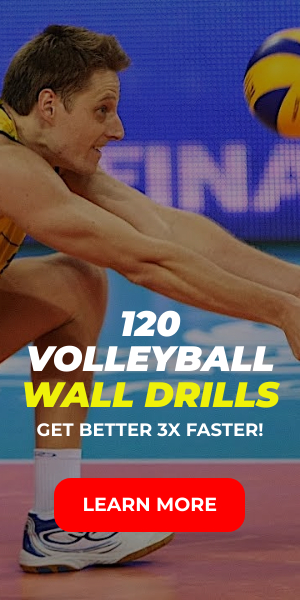I got a suggestion from you in the comments for a great topic and that’s how to attack pipe, so today’s video will be all about pipe. Attacking pipe is a huge weapon in volleyball. Pipe is one of the most effective attacks, also all the top volleyball teams include pipe attacks into their game.
I believe that you also want to attack well and play a great pipe, so I have tips and advice for you on how to play pipe, what are the advantages of pipe, what types of pipe you can play, where you should attack pipe and what is the most important thing when playing pipe.
Pipe time
I loved attacking the pipe myself, if we passed well and the setter set me a quick pipe. I knew I would have at most a one block against me and I often hit with a maximum power to an empty net. That was a great feeling. Also, for example, when we played against Brazil in the World Championship they literally destroyed us with the quick pipes, we didn’t know how to defend this huge weapon. Almost in every action they threatened with the fast pipe, it was almost a first tempo attack, they played it really fast. And when I watch the best volleyball on volleyballworld.tv every week, I see what a weapon the pipe is in modern volleyball.
So in this video, I want to share with you my outside hitter’s experience from three world championships and modern trends that you can use yourself when playing the pipe.
Advantages of the pipe
Pipe has several advantages:
1. 4 attacking players
First of all, if we incorporate player from zone six on the pipe, we expand the number of our hitters. We won’t be attacking with only three players, which are classically outside hitter, middle blocker and opposite, but we will involve a fourth player. And more attacking options team has, where and when to attack, where to threaten with attack, is always better.
2. More pressure
By having 4 offensive players ready, we make it more difficult for the opponent to defend our attacks. We are creating more pressure. Imagine that, you’re on the block. The opponent has a good pass and suddenly there are four players on the move, all expecting a quick set. You don’t know if the setter will set quick set to the middle blocker or if he will set the pipe, or if a quick set will come to the outside hitter. You’re just under more pressure than if there were only three players attacking.
3. Fast attack
Pipe is a fast type of attack, it is often surprising and the opponent doesn’t have much time to react. He doesn’t have time to set up a double block or move in the field and defend successfully.
4. Better efficiency in attack
And if you play the pipe well, you have one of the highest percentage opportunities to score a point, you will have higher efficiency in attack. The successful percentages from the pipe attack are higher than from traditional spikes from outside hitters or opposites in the vast majority of cases.
But let’s get to the pipes themselves. What types of pipes can we play?
Quick pipe
The quick pipe is the most effective after an ideal reception or excellent defense when the ball goes high to the net into the hands of the setter. This combination is, in my eyes, the most effective attack of all attacks if executed correctly. Why do I think that?
1. Quickly executed attacks always have a better chance of success.
Look at the numbers of middle blockers on offense, as a rule their attack percentages are almost always higher than outside hitters and opposites. Their percentages are higher precisely because of the speed of the attacks, when the opponent doesn’t have much time to react. And that’s also the case when we play quick pipe.
2. Wide angles of attack
With the pipe, we have the whole field in front of us, nine meters wide. We can hit to zone one, zone six and zone five. Because we have the ball in front of us, we can choose where to attack.
3. We see the block
When we get a quick pipe, we usually don’t have a compact block against us, but only the middle blocker, who is often anyway late on the block because he had to wait for a possible attack by the middle blocker. And we have the opportunity to watch where he jumps and change the direction of our attack, we are at a great advantage.
High emergency pipe
But we don’t play the pipe only in ideal situations, sometimes we play high pipe, I call it emergency pipe. We play this type of pipe if we have no other place to set the ball or if we are in a difficult situation. During the game it happens that we don’t receive the ball well, rather we pass it somewhere next to the court, the setter doesn’t get to it. For example, opposite has to set this ball and he usually isn’t capable to set an accurate set to 12 metres, so he chooses to set the ball to the middle of the field, to the pipe. And it’s in this situation that we’re forced to play the emergency pipe. A pipe that’s high over the net, it’s more like a high set to the outside hitter to position four, it’s an emergency attack.
In this case, scoring a point from the pipe is very difficult. It’s a high set, as an attacker I have time for attack, but so does the defense on the block against me. I can count on a three-block against my attack. I can count on the fact that I can’t attack over the block from the pipe. If the triple block is well placed, there is almost no room left for me to hit next to the block into the court.
And when I do hit into the court, there are defensive players standing there. It’s really not easy task to attack a high emergency pipe against a compact defense. But anyway, you can solve this situation. What are my options to attack this emergency pipe?
1. Aggressive attack
I prefer aggressive attacks, if the set is good, I am in a position where I have the ball high in front of me. Therefore, my first choice would be to attack this pipe aggressively into the block, not so that the block blocks me, but so that I hit the palms or fingertips of the blocking players. If I hit the palms, I have a good chance of the ball bouncing with a good parabola from the block to us in the field and we will have a chance to attack again. If my attack from the pipe goes to the fingertips of the blocking players, I again have a good chance of the ball bouncing far behind the field and I get a point.
2. Tip behind the block
Sometimes, however, a tip behind the block is also a good choice and can bring me a point. I would definitely recommend you to make more tips into zone two or to zone one.
In this zone, the setter or the opposite is defending, and either I knock the setter out of the following set, or the opposite will be on the ground and not a threat to the following attack by the opponent.
3. Power tip or pass into block
The last option to deal with this difficult situation when attacking pipe against a compact block is to try to find a error in the block with a power tip or pass the ball with both hands into the block. Either I can find the mistake on the block, and score a point, or my team has a great chance to defend the bounced ball away from the block and develop another offensive combination.
Surprise pipe
And I can’t forget about the surprise pipe, the kind of pipe that Earvin Ngapeth plays. This is a pipe where the setter in defense picks up the first ball and directs it to the middle of the field.
The outside hitter, who plays in zone 6, runs out and can make a surprise hit or a surprise set from that ball. When you see this in real life situations at the highest level, these are always very spectacular actions and the crowd gets out of their seats. On the other hand it’s not easy to learn this surprise pipe.
Now let’s speak about points. If you want to be successful on the pipe, you have to know where to hit it.
Where to attack the pipe?
So where should you attack the pipe? There are several answers to this question depending on the situation you are in when you attack the pipe.
1. Pipe without the block
The best situation is when you don’t have a block in front of you, when you attack without the block. The setter has done a great job, our blocker made his job and blocking middle blocker has followed up on his potential attack.
When attacking in this situation, you can actually choose any spot in field to attack. The most secure attack is to attack straight ahead into zone six. Yes, there will be a defensive player facing you, but you have a big advantage, you’re hitting without a block. You can attack with maximum force and the chances of the defending player are very low.
2. Attack against single block
Now you are in situation when you have a one blocker in front of you, 90% of the time it will be a middle blocker who puts a block against you. In this case you can no longer hit straight ahead, you would not be successful there. You would have to hit zone one or zone five. I recommend you hit more into zone one. Because in zone five, the libero is usually defending and he is the best defender of the team and he can catch your excellent pipe. On the other hand, in zone one is often the opposite, who is on the field for other reasons and he is not often the best defensive player.
Either way, you still have a big advantage over the defense. You definitely shouldn’t use your body to indicate where you’re going to attack, don’t run straight for diagonal attack, in the 5 position. Change direction at the last moment, sometimes only with your hand. Because even a blocker who reads the movements of the attacking players well can block you in this situation.
3. Double block or triple block
Double to triple block situation. Although you are playing a quick pipe, the defense at the net has read our offensive intentions and you are facing at least a double block.
You see outside hitters more often on the double-block on the pipe, and they often help their middle blockers in this way even against quick attacks by middle blockers. So if you see a double block of a middle blocker and an outside hitter in front of you, direct your attack to zone one again. Also, when there is a setter on the block, and I mean a setter of smaller stature, you can expect that he will not often help middle blocker to block the pipe and this is also the way to attack to zone one.
Also, sometimes you will get a triple block formed against you, it’s usually not compact, players are more likely flying to form the block. In these situations, you already need to have good peripheral vision, see the block and attack where the block is not compact or where there is a hole in the block.
I definitely think the pipe attack is a huge weapon that can win you a lot of games. But I haven’t told yet you what’s the most important when playing the pipe.
The 2 most important things when playing the pipe
The most important thing is that the pipe attack should be unreadable on the setter, so that you can’t tell where the setter is setting. The setter should not play the pipe every time on a good reception. The setter should be able to integrate pipe attacks appropriately into his offensive strategy. And from a attacker’s perspective, your attack should be unpredictable, you shouldn’t aim your pipe all the time in zone 5, attacking into one spot. Instead, you should use multiple directions to attack, so that either blockers or players in defense can’t defend you.
I hope these tips and advice on how to attack the pipe in volleyball will help you become a better player.
I’ll see you in the next video
Bye





